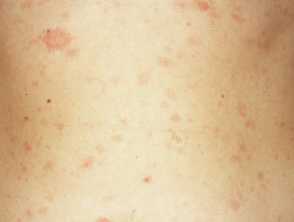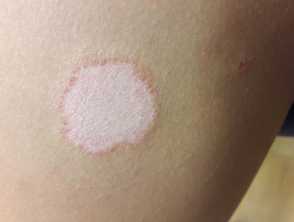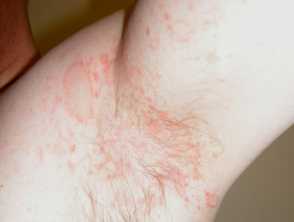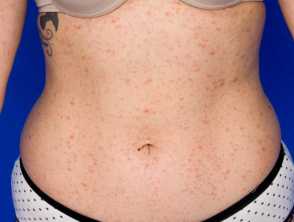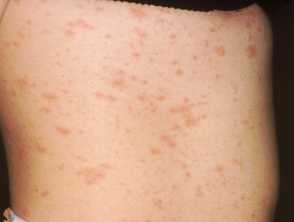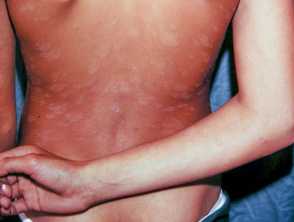What is pityriasis rosea?
Pityriasis rosea is a self-limiting rash, which resolves in about 6–10 weeks. It is characterised by a large circular or oval "herald patch", usually found on the chest, abdomen, or back.
The herald patch is followed some time later, typically two weeks or so, by the development of smaller scaly oval red patches, resembling a Christmas tree, distributed mainly on the chest and back.
Who gets pityriasis rosea?
- Pityriasis rosea is most common in teenagers and young adults (10–35 year-olds), however it can affect people of any age
- Occurs very slightly more often in women
- Approximate incidence of 0.5% to 2%
- Most cases occur in winter
What causes pityriasis rosea?
The exact cause is not known. Viral, bacterial, and non-infective causes have been hypothesised.
Reports suggested pityriasis rosea may be caused by:
- Viral infections
- Herpesviruses 6 and 7 (HHV-6/7) have the strongest known association, however studies have not been confirmatory.
- Other viral infections, such as H1N1 influenza A and COVID-19, may also be causative.
- Drug-induced reactions
- Many drugs have been associated, such as angiotensin-converting enzyme inhibitors, nonsteroidal anti-inflammatory drugs, hydrochlorothiazide, gold, captopril, atypical antipsychotics barbiturates, D-penicillamine, imatinib, metronidazole, isotretinoin, clozapine, and clonidine.
- Vaccines
- Pityriasis rosea may be triggered by the Bacillus Calmette-Guerin (BCG), H1N1, diphtheria, smallpox, hepatitis B, Pneumococcus, and COVID-19 vaccines.
What are the clinical features of pityriasis rosea?
Systemic symptoms
Except for mild to severe itching in up to 25% of patients, no systemic symptoms are typically present during the rash phase of pityriasis rosea. A few days before the rash develops, up to 69% have flu-like symptoms eg, cough or sore throat.
The herald patch
The herald patch is a single patch that appears before the generalised rash of pityriasis rosea. It is a slightly raised, oval, salmon-pink or red plaque 2–5 cm in diameter, with a peripheral scale trailing just inside the edge of the lesion, like a collaret.
See more pityriasis rosea images
Secondary rash
A few days to a few weeks later after the appearance of the herald patch, more scaly patches or plaques appear on the chest and back, most often appearing from the top down. A few plaques may also appear on the thighs, upper arms, and neck, but are uncommon on the face, scalp, palms, or soles.
These secondary lesions tend to be smaller than the herald patch. They are also oval in shape with a dry surface and the long axis of the oval lesion is often orientated around the ribs. Like the herald patch, they may have an inner collaret of scaling. Some plaques may be annular.
Pityriasis rosea patches and plaques usually follow the relaxed skin tension lines or cleavage lines (Langer lines) on both sides of the upper trunk. The rash has been described as looking like a Christmas tree in distribution. Worsening of the rash or a second wave of lesions is not uncommon before eventual spontaneous resolution of the eruption. In children the distribution and lesions are often atypical.
See more pityriasis rosea images
Atypical pityriasis rosea
Pityriasis rosea is said to be atypical when diagnosis has been difficult. Atypical pityriasis rosea may be diagnosed when the rash has features such as:
- Atypical morphology, eg papules, vesicles, urticated plaques, purpuric, or target lesions (erythema multiforme-like)
- Large size or confluent plaques
- Unusual distribution of skin lesions, for example an inverse pattern, with prominent involvement of the skin folds (armpits and groin), or involvement of the limbs but the trunk is spared
- Involvement of mucosal sites, eg, mouth ulceration
- Solitary herald patch without generalised rash
- Multiple herald patches
- Absence of herald patch
- A large number of patches
- Severe itch
- A prolonged course of the disease
- Multiple recurrences.
How do clinical features vary in differing types of skin?
The pityriasis rosea rash often leaves behind patches of lighter (hypopigmented) or darker (hyperpigmented) discolouration. This may be more obvious in darker-skinned people and may take months to return to normal appearance.
What are the complications of pityriasis rosea?
In most cases, pityriasis rosea is harmless. However, there are reports of complications such as:
- Premature delivery and foetal demise during pregnancy, within the first 15 weeks of gestation
- A severe cutaneous adverse reaction (drug hypersensitivity syndrome) due to reactivation of herpes 6/7 in association with a drug
- Prolonged skin discolouration.
How is pityriasis rosea diagnosed?
Identification can be challenging at the onset of symptoms. There are no non-invasive tests that confirm the condition. The diagnosis is usually made clinically but may be supported by:
- Histology — subacute dermatitis is seen on histology
- Eosinophils are typical of drug-induced pityriasis rosea.
Blood testing for HHV6 (IgG or PCR) is not indicated because nearly 100% of individuals have been infected with the virus in childhood and commercial tests do not currently measure HHV6 activity.
If the diagnosis is uncertain, especially if the palms and soles are affected, it is important to consider the possibility of other conditions.
Table 1. Proposed diagnostic criteria for pityriasis rosea
| Clinical features | Criteria |
| Essential |
|
| Optional (At least one of the following features) |
|
| Exclusion |
|
Source: Zawar V, Chuh A. Applicability of proposed diagnostic criteria of pityriasis rosea:
results of a prospective case-control study in India. Indian J Dermatol. Nov 2013
What is the differential diagnosis for pityriasis rosea?
- Lichen planus
- Psoriasis
- Pityriasis rubra pilaris
- Erythema multiforme
- Guttate psoriasis
- Secondary syphilis
- Pityriasis alba
- Seborrhoeic dermatitis
- Tinea corporis
- Tinea versicolor
What is the treatment for pityriasis rosea?
General measures
While pityriasis rosea is a self-limiting disease, an important goal of treatment is to control pruritus, which may be severe in 25% of patients. In addition to education and reassurance, many patients will benefit from:
- Applying moisturising creams to dry skin
- Bathing or showering with plain water and bath oil, aqueous cream, or another soap substitute
- Exposing skin to sunlight cautiously (without burning).
Specific measures
The following therapies may help with the symptoms and speed up clearance:
- Medium potency topical steroid creams/ointments and oral antihistamines may reduce the itch while waiting for the rash to resolve.
- For patients with severe itching, treatment with zinc oxide, calamine lotion, and even oral steroids may be helpful. Routine use of oral steroids is not recommended due to risk for relapse after treatment and limited evidence.
- A 7-day course of aciclovir may lead to faster resolution of lesions and help to relieve itching in severe cases
- Extensive or persistent cases can be treated by phototherapy (narrowband ultraviolet B therapy)
- Macrolide antibiotics were once advocated, but do not appear to be beneficial.
What is the outcome for pityriasis rosea?
Pityriasis rosea will resolve in about 6–10 weeks. Skin discolouration may persist for a few months in darker-skinned people but eventually the skin returns to its normal appearance.
Recurrence of pityriasis rosea outside the acute phase is rare (1–3%), perhaps adding weight to the suggestion that there is long-lasting immunity after a proposed infection. However, a different viral infection may trigger recurrence years later.
